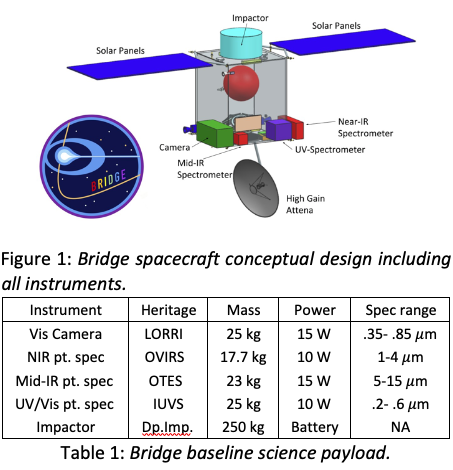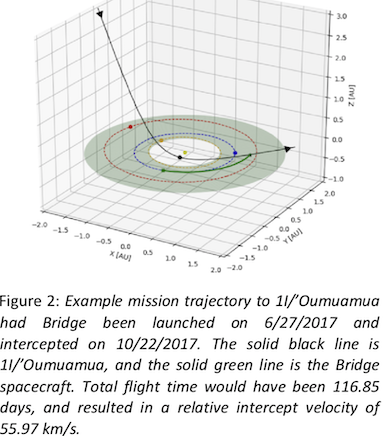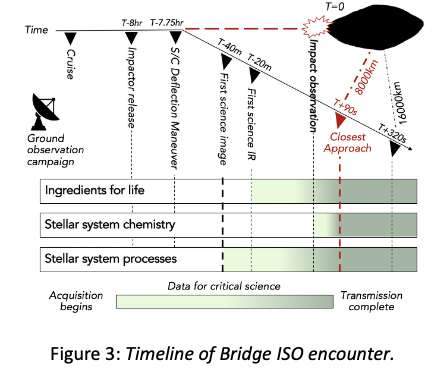Bridge To The Stars: A Mission Concept And Policy To Enable An Inner Solar System Encounter With An Interstellar Object
- 1Southwest Research Institute, Space science and engineering, san antonio, United States of America (kristie.llera@gmail.com)
- *A full list of authors appears at the end of the abstract
Abstract: The study of exoplanets is essential to expanding our understanding of solar system formations, as well as, the development of life in the universe [1]. Unfortunately, with the vast distances between stars, we observe limited aspects of these exoplanetary systems by telescope. With the recent discovery of two interstellar objects (ISOs), one volatile-poor (1I/’Oumuamua [2]), and one volatile-rich (2I/Borisov [3]), we can detect and observe exoplanetary material bound for our solar system. We propose a new mission concept (Bridge) to flyby a yet-to-be-discovered ISO as it passes through our inner solar system. Bridge is feasible under NASA’s New Frontier’s class-mission; however, it will require changes to future NASA Announcements of Opportunity (AO) to provide long-term spacecraft storage and rapid launch response capabilities. While other ISO mission concepts require long-term missions as the ISO encounter occurs outside our solar system, Bridge is designed for an ISO encounter within 0.7-2 AU; streamlining the architectural design. Bridge would provide a unique opportunity to gain insight into physical, chemical, and biological differences between our solar systems as well as transport of planetary materials between them. An active community of ground-based surveys is key to catching potential targets. NASA ground-based telescope campaigns are awarded independently of mission AO. Providing an option to include ground-based observation time to secure the needed resources for optimum mission success, would be advantageous for these once-in-a-lifetime encounters. Bridge was designed during NASA’s 31st Planetary Science Summer Seminar [4].
Science goals & objectives: Bridge has two science goals: (1) determine whether prebiotic chemical ingredients can be transported between stellar systems and the interstellar medium, and (2) determine if interstellar objects form via the same processes as objects within our solar system. To address the first goal, Bridge would look for spectral signatures from CH, N2, polycyclic aromatic hydrocarbons, and tholins. To address the second goal, Bridge would compare its elemental abundances, isotope ratios, and relative abundances of noble gases to those of other solar system objects and presolar grains (e.g. [6]). Bridge would also look for the presence of ices, the molar abundances of minerals, and the morphological properties of the ISO to 10 m resolution in order to determine if the ISO is similar to any objects in our own solar system.

Science payload: Bridge’s instrument payload can address the aforementioned science goals and objectives regardless of the specific properties of the target ISO. Bridge utilizes a remote sensing suite consisting of a mid-infrared spectrometer, a near-infrared spectrometer, an ultraviolet/visible spectrometer, and a visible light camera. Bridge also employs a battery-powered guided impactor, based on the impactor from Deep Impact [7], to expose the ISO’s interior material. Table 1 lists the instruments and their properties. The high relative encounter velocities of our mission preclude direct in-situ sampling. All instruments in our selected payload are based on previously flown instruments.
Mission design: Bridge is designed to flyby a yet-to-be-discovered ISO. Multiple telescopic survey facilities exist that scout the sky for Near-Earth Objects, comets, and possible ISOs. It is estimated that ≈0.2 ISO detections should occur per year, and when future survey telescopes such as the Large Synoptic Survey Telescope become operational, the number of ISO detections should improve to ≈1 per year [8]. Bridge is designed to wait in storage on Earth until a suitable ISO is detected.
Bridge requires three criteria to be satisfied for a successful ISO flyby: (1) the ISO must pass through the ecliptic plane at a distance between 0.7 and 2.0 AU from the Sun (green region in Figure 2), (2) the relative encounter velocity must be less than 70 km/s, and (3) the total launch C3 is less than 60 km2/s2 for the intercept maneuver, which is achievable given the mass of Bridge and an Atlas V 431 launch vehicle. With these criteria, Bridge could encounter 65% of ISOs whose orbital characteristics are predicted by [1]. Figure 2 illustrates a hypothetical encounter with 1I/’Oumuamua that meets all the aforementioned criteria.

In a 70 km/s flyby scenario, the impactor would be released approximately eight hours before the main spacecraft achieved its closest approach. Fifteen minutes later the main spacecraft would perform a deflection maneuver, steering it to a safe closest approach distance of 8000 km. Thirty seconds prior to impact, the IR spectrometer and visible camera would observe the surface composition. The visible camera would capture a video at the time of the impact, at which point the UV spectrometer would image the ejecta plume flash. Following the impact, the spectrometers would continue to take measurements of the plume. All critical science data would be transmitted before the spacecraft’s closest approach to the ISO ninety seconds after impact. The complete encounter timeline is shown in Figure 3.

Recommendations: To enable Bridge in response to the unique and ephemeral nature of ISOs, several technological advancements and policy changes must occur. This includes: improved ground detection capabilities of small bodies, infrastructure to store a spacecraft in a launch-ready state, rapid launch response, and the opportunity to propose a mission that requires these capabilities. The planetary science community must advocate for language explicitly permitting mission architectures that include storage and rapid launch in future NASA New Frontiers, Discovery, and SIMPLEx AO.
Acknowledgments: This work was supported by NASA’s Planetary Science Division and NASA’s Radioisotope Power System program. The information presented about the Bridge mission concept is predecisional and is provided for planning and discussion purposes only. We thank JPL’s A-Team and TeamX for concept development support, and Leslie Lowes and Joyce Armijo for programmatic support.
References: [1] D. Seligman and G. Laughlin. AJ.,155(5):217, 2018. [2] K.J Meech et al. Nat., 552(7685), 2017. [3] P. Guzik et al. Nat. Astronomy, 2019. [4] C.J. Budney et al. LPSC 50, (3225), 2019. [5] National Research Council. The Ntl. Acad. Press, 2011. [6] A. Davis. Proc. of the Ntl. Acad. of Sci.,108(48):19142–19146, 2011. [7] M.F. A’Hearn et al. Sci.,310(5746):258–264, 2005. [8] D.E. Trilling et al. ApJ., 850(2):L38, 2017.
K. Moore2, S. W. Courville3, K. Connour4, S. Ferguson5, R. Agrawal6, D. Brack7, P. Buhler8, E. Czaplinski9, M. DeLuca4, A. Deutsch10, N. Hammond11, D. Kuettel4, A. Marusiak12, S. Nerozzi13, A. Schoenfeld14, J. Tarnas10, A. Thelen15, J. Stuart8, J. Castillo8, D. Landau8, W. Smythe8, C. Budney8, K. Mitchell8 (2Harvard, Cambridge, MA. 3Planetary Science Institute, Lakewood, CO. 4University of Colorado, Boulder, CO. 5Arizona State University, Tempe, AZ. 6Purdue University, West Lafayette, IN. 7Lockheed Martin Space, Denver, CO. 8Jet Propulsion Laboratory, California Institute of Technology, Pasadena, CA. 9University of Arkansas, Fayetteville, AR. 10Brown University, Providence, RI. 11Wheaton College, Norton, MA. 12University of Maryland, College Park, MD. 13University of Arizona, Tucson, AZ. 14University of California, Los Angeles, CA. 15Goddard Space Flight Center, Greenbelt, MD.)
How to cite: LLera, K. and the NASA 31st PSSS group: Bridge To The Stars: A Mission Concept And Policy To Enable An Inner Solar System Encounter With An Interstellar Object, Europlanet Science Congress 2020, online, 21 September–9 Oct 2020, EPSC2020-575, https://doi.org/10.5194/epsc2020-575, 2020

